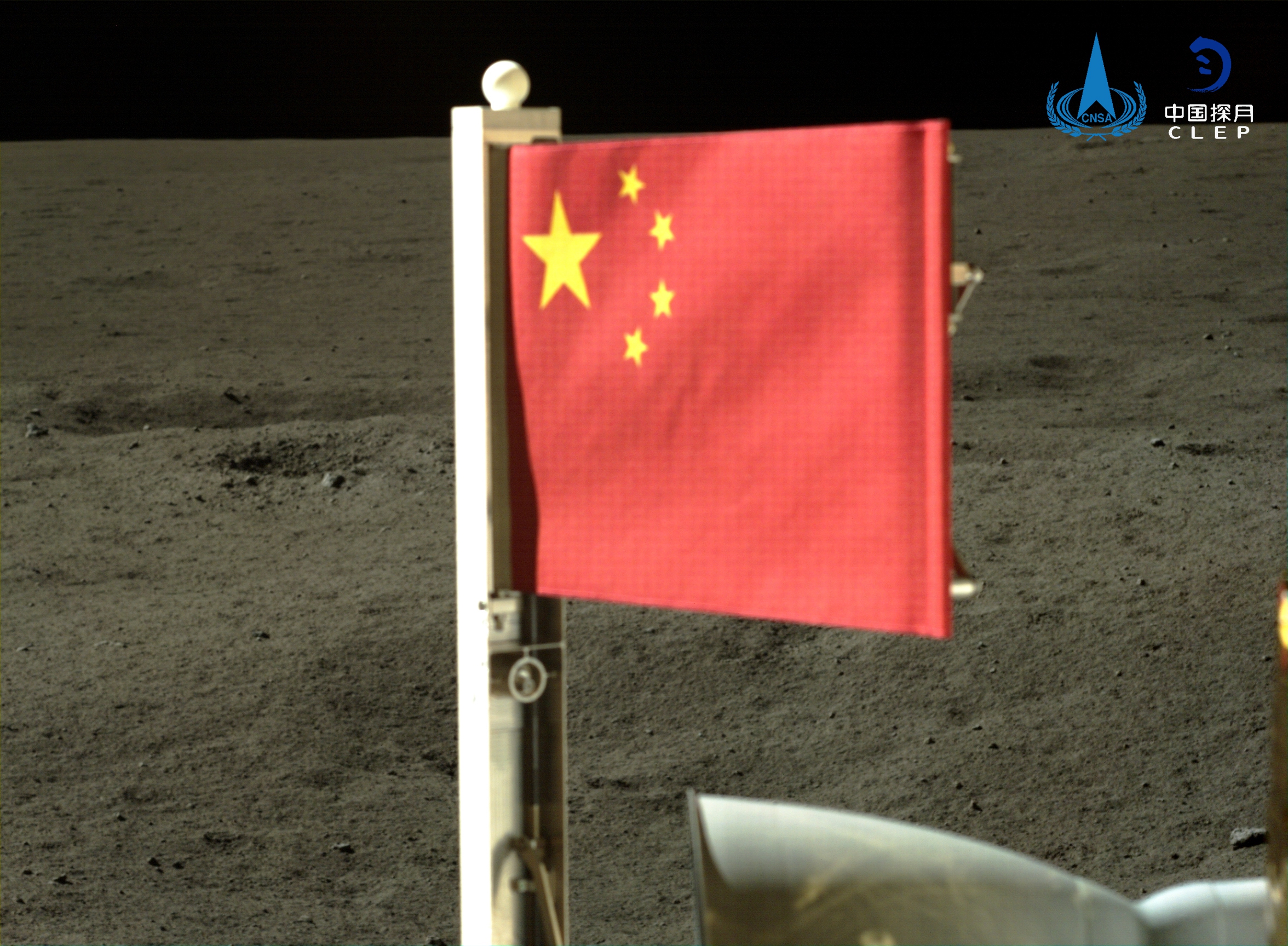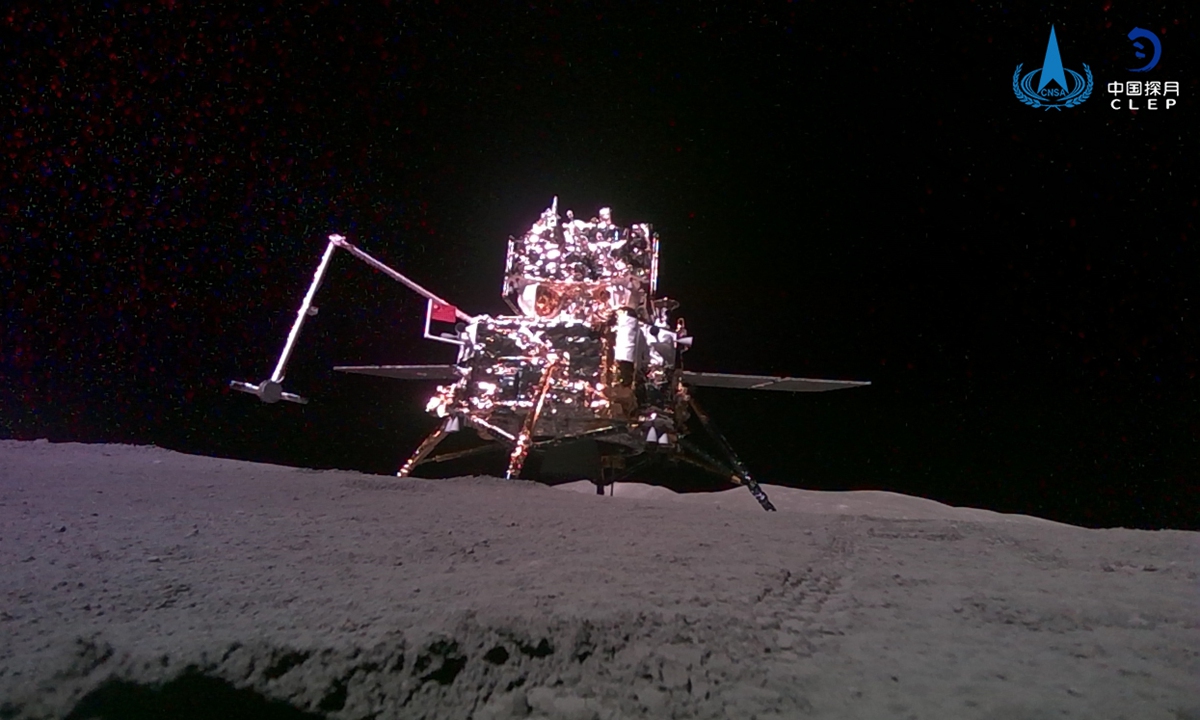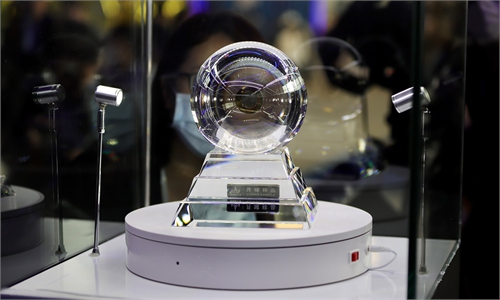Carrying first samples collected from far side of moon, Chang'E-6 embarks on journey home

Photo: CNSA
Carrying valuable rocks and dust collected from the far side of the moon, the ascender of China's Chang'e-6 lunar probe officially embarked on its journey back to Earth, moving toward the goal of returning precious rock and soil from this region to Earth for the first time in history.
The Global Times learned from China National Space Agency (CNSA) on Tuesday that after being powered by the 3000-newton engine for approximately six minutes, the ascender of Chang'e-6 lifted off from the lunar surface and entered its preset lunar orbit with success at 7:38 am on Tuesday.
The lunar probe, named after a moon goddess in Chinese mythology and the sixth in the decades-long space program, completed sample collecting mission in the South Pole-Aitken Basin on the far side of the moon from Sunday to Monday, in an intelligent and rapid fashion, per the CNSA.
Although China's high success rate in lunar probe missions makes even the unprecedented achievements seem routine, it is the country's steadily advancing space technology through a composed, methodical approach that has underpinned this success, Kang Guohua, a professor of Aerospace Engineering at Nanjing University of Aeronautics and Astronautics, told the Global Times on Tuesday.
Kang also highlighted the significance of China's Queqiao-2 relay satellite in the unprecedented feat, saying it is also the one and only deep space relay communication network in the world and that the Tuesday achievements proved its efficiency and capability. Queqiao, literally meaning Magpie Bridge, is also from Chinese folktale where magpies formed a bridge to allow a separated couple to communicate across the Milky Way.
During the sampling and storage process, Chinese researchers in ground laboratories simulated the sampling area's geographic model based on data sent back by Queqiao-2 relay satellite. This simulation provided critical support for decision-making and the operation of various stages of the sampling process, Global Times has learned.
The probe has overcome significant challenges brought by the high temperature on the far side of the moon and successfully carried out the sampling process, a core task in its current mission. Using two methods - drilling with a drill and surface collection with a robotic arm - it enabled automated, diverse sampling at multiple points, per mission insiders.
Senior space expert Pang Zhihao told the Global Times that compared with the Chang'e-5 mission that conducted sampling on the near side of the moon, performing the same task on the far side presented greater challenges.
Due to the time limitations of relay communication, the time window for Chang'e-6 was reduced from 21 hours for Chang'e-5 to 14 hours. To address this, Chang'e-6 improved its sampling efficiency by advancing the intelligent and rapid sampling technology on the far side, enhancing both the autonomy and efficiency of the sampling process, Pang explained.
The Chang'e-6 lander is equipped with various instruments, including a descent camera, a panoramic camera, a lunar soil structure detector, and a lunar mineral spectrometer.
These instruments, smoothly powered on, executed planned scientific investigations. They played a crucial role in undertaking tasks such as examining the lunar surface's morphology and mineral composition and detecting the moon's shallow subsurface structure.
Before the probe drilled for samples, the lunar soil structure detector analyzed the subsurface structure in the sampling area, providing valuable data for the sampling process.
After surface sampling, the Chinese national flag carried by the Chang'e-6 lander was successfully unfurled on the far side of the moon, marking China's first dynamic display of its national flag on the lunar far side.
"The national flag will arouse patriotic enthusiasm among Chinese people around the world. I think people across the country are looking forward to the picture and are proud of our great motherland," said Zhou Changyi, chief designer of the Chang'e-6 probe's payload subsystem and a research fellow with the National Space Science Center under the Chinese Academy of Sciences.
The national flag displayed on Chang'e-6 was made by researchers using basalt melt drawing technology after more than one year of hard work.
"It has stronger corrosion resistance, high temperature resistance, low temperature resistance and other excellent properties," Zhou told the Global Times on Tuesday.
Because the lunar surface is rich in basalt, if we build a lunar base in the future, we will most likely have to make basalt into fibers to make building materials, Zhou revealed.
Unlike launches from the Earth, the Chang'e-6 ascender did not have a fixed launch tower system. Instead, the lander served as a "temporary tower," according to mission insiders.
The ascender's launch from the moon's far side posed greater challenges compared to the Chang'e-5 mission, as it could not directly receive ground control support and had to rely on the Queqiao-2 relay satellite and its own special sensors for autonomous positioning and attitude determination.
After ignition and liftoff, the ascender went through vertical ascent, attitude adjustment, and orbit insertion phases, successfully entering the predetermined lunar orbit.
During the ascent and orbit insertion phases, all actions were autonomously performed by the intelligent system. China's navigation and control system was extremely stable and precise, demonstrating the excellence and stability of the navigation control system developed by the state-owned contractor CASC, Pang said.

A picture of the Chang'e-6 lunar probe's lander and ascender vehicles on the surface of far side of moon taken by a mobile camera on June 3, 2024 Photo: Courtesy of the CNSA
International efforts
International payloads onboard the Chang'e-6 lander, including the European Space Agency's (ESA) Negative Ions on Lunar Surface (NILS) and France's lunar radon detector, operated normally and conducted their respective scientific tasks, the CNSA said in a statement it provided to the Global Times on Tuesday.
The French lunar radon detector functioned during the Earth-moon transfer, lunar orbit, and lunar surface stages. The ESA's lunar surface negative ion analyzer operated during the lunar surface stage.
Additionally, an Italian laser retroreflector mounted on the top of the lander serves as a position control point for distance measurements on the far side of the moon, the CNSA disclosed.
Sending congratulations on the Chang'e-6 mission, Josef Aschbacher, director general of the ESA, said on X on Tuesday morning, "Incredible! Congratulations to the Chinese National Space Agency on the remarkable success of Chang'e-6 mission thus far."
"It's a wonderful accomplishment that ESA is thankful and proud to have a part in by contributing the NILS instrument and by providing ground station ESTRACK network support," read the X post.
ESA's tracking station network - ESTRACK - is a global system of ground stations providing links between satellites in orbit and ESOC, the European Space Operations Centre, Darmstadt, Germany, according to the ESA website.
Next, the ascender will rendezvous and dock with the orbiter-returner combination waiting in the lunar orbit. The lunar samples will be transferred to the returner.
The orbiter-returner combination will then fly in lunar orbit, waiting for the right moment to transfer back to Earth. Near Earth, the returner will re-enter the atmosphere carrying the lunar samples, with plans to land in the Siziwang Banner landing site in North China's Inner Mongolia Autonomous Region.
On May 3, the Chang'e-6 probe was launched. After experiencing lunar orbit insertion and the separation of the lander-ascender combination and the orbiter-returner combination, it successfully landed in the pre-selected landing area of the South Pole-Aitken Basin on the far side of the moon on June 2.
Landing on the moon is difficult. Of the five robotic landers that have made the attempt in the past year, only two have succeeded.
Both successful landers were sent by national space agencies - those of India and Japan - though the Japanese probe, called SLIM, suffered an engine failure and landed upside down.
The BBC applauded China's feat in a Tuesday report while saying that scientists worldwide are excited about what samples China could collect. The probe could extract some of the moon's oldest rocks from a huge crater on its South Pole.
"Everyone is very excited that we might get a look at these rocks no one has ever seen before," explains Professor John Pernet-Fisher, who specializes in lunar geology at the University of Manchester.
"It would help us answer those really big questions, like how are planets formed, why do crusts form, what is the origin of water in the solar system?" the professor said.


